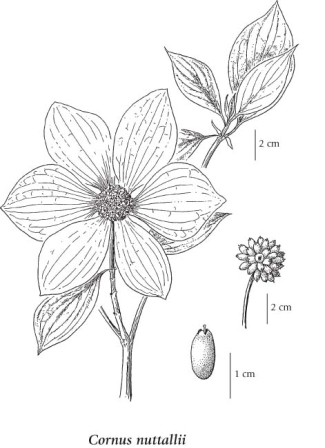Cornus nuttallii Audubon ex Torr. & A. Gray
western flowering dogwood (Pacific dogwood)
Cornaceae (Dogwood family)
Introduction to Vascular Plants
western flowering dogwood (Pacific dogwood)
Cornaceae (Dogwood family)
Introduction to Vascular Plants
Introduction
Pacific dogwood is a small native tree species (to 20 m tall) that is found along the Pacific Coast of North America from California to British Columbia (USDA 2010). In British Columbia, it is found in the southwestern corner of the province, both on the mainland and on Vancouver Island. It occurs on mesic, nitrogen-rich forest soils, and is a relatively common part of the shrub layer in mixed and coniferous forests in the region. During spring flowering, this species is readily visible along forest edges prior to full leaf out. The large showy 'flowers' are distinctive and eye-catching. The 4-7 large white or pink-tinged 'petals', however, are actually bracts. The actual flowers are tiny (1.5-2 cm wide), greenish-white (usually purple-tinged or purple-tipped), and occur in clusters in the center, framed by the large bracts. The oval leaves are opposite, and have characteristic 'Cornus' veins that curve parallel to the leaf edge.
The Pacific dogwood was adopted as British Columbia's official floral emblem in 1956. |
Species Information
General:
Irregularly branched deciduous tree up to 20 m tall; bark blackish-brown, smooth, becoming finely ridged with age, young branches greyish-purplish.
Leaves:
Opposite, deciduous, oval, stalked, pointed at the tip, 4-10 cm long, deep green above, greyish-brown below, turning red in the fall, characteristic veins curving parallel to the leaf edge.
Flowers:
Inflorescence of numerous, unstalked, hemispheric clusters 1.5-2 cm wide, subtended by 4-7 conspicuous white or pinkish-tinged, large (2-7 cm long) showy bracts, flowering in spring and often again in the fall; petals greenish-white, usually purplish-tinged.
Fruits:
Fleshy drupes, 10 mm long, bright red.
Illustration

If more than one illustration is available for a species (e.g., separate illustrations were provided for two subspecies) then links to the separate images will be provided below. Note that individual subspecies or varietal illustrations are not always available.
Illustration Source: The Illustrated Flora of British Columbia
USDA Species Characteristics
Flower Colour:
Green
Blooming Period:
Mid Spring
Fruit/Seed characteristics:
Colour: Red
Present from Summer to Fall
Source: The USDA
Ecology
Ecological Framework for Cornus nuttallii
The table below shows the species-specific information calculated from
original data (BEC database) provided by the BC Ministry of Forests and Range.
(Updated August, 2013)
The table below shows the species-specific information calculated from
original data (BEC database) provided by the BC Ministry of Forests and Range.
(Updated August, 2013)
| Site Information |
Value / Class |
||
|
Avg |
Min |
Max |
|
| Elevation
(metres) |
194 | 0 | 833 |
| Slope
Gradient (%) |
28 | 0 | 95 |
|
Aspect (degrees) |
217 | 22 | 360 |
| Soil
Moisture Regime (SMR) [0 - very xeric; 4 - mesic; 8 - hydric] |
3 | 0 | 7 |
| Modal
Nutrient Regime
Class |
C | ||
| #
of field plots species was recorded in: |
232 | ||
| Modal
BEC Zone Class |
CWH | ||
|
All BEC Zones (# of stations/zone) species was recorded in |
CDF(82), CWH(132), ICH(2), IDF(4), SBS(1) | ||
|
Source:
Klinkenberg 2013
|
|||